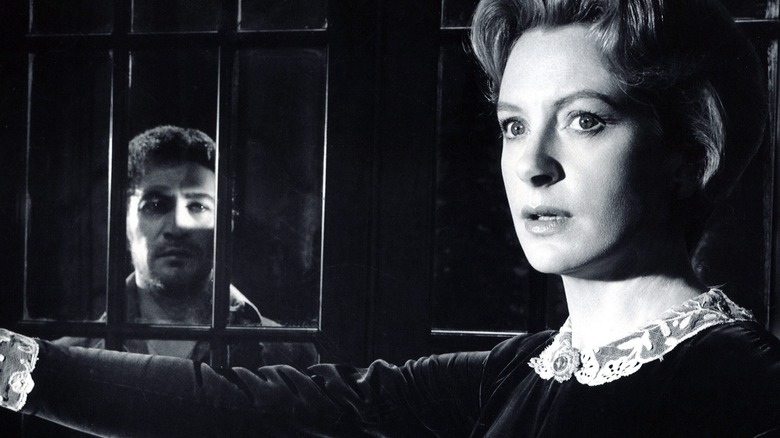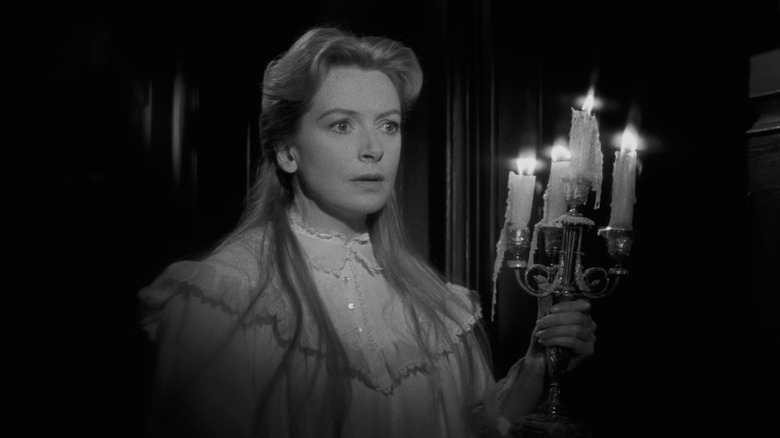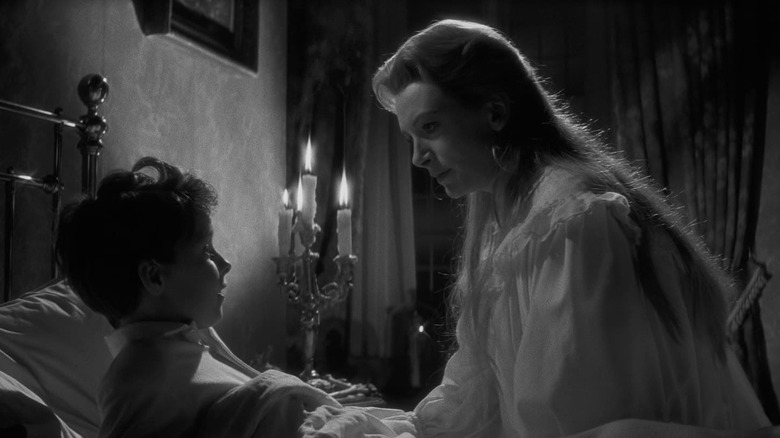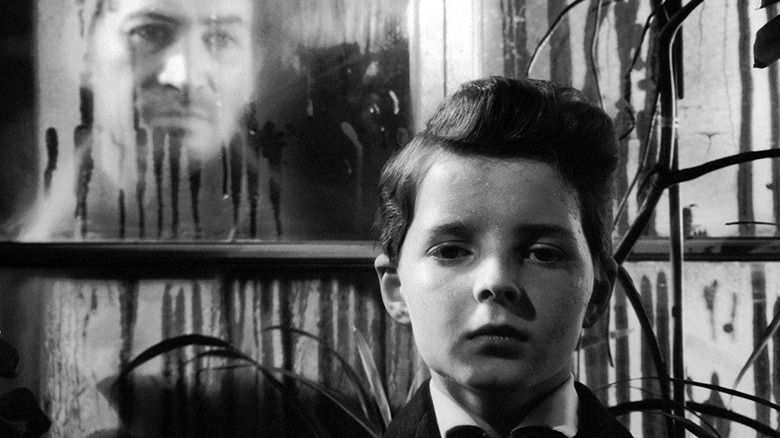60 Years Later, The Innocents Is Still One Of The Scariest Films Ever Made
For literature students the world over, Henry James's "The Turn of the Screw" is a highly familiar text. The ghost story novella, about a naïve governess who is convinced her wards are possessed by malevolent spirits, is the ideal starter text for digging into themes of ambiguity and psychoanalytic theory. Academics have spent the best part of a century arguing over its conclusion: is this the story of a heroic young woman who saves innocent children from the evil ghosts of the castle's former workers or is she simply mad? Various films and TV shows have tried to answer that question too, from 2020's "The Turning" to Netflix's "The Haunting of Bly Manor "to even a parody in "Star Trek: Voyager" via Captain Janeway's holodeck adventures. The best adaptation, however, is the first big-screen one, from 1961. 60 years later, it remains one of the scariest movies ever made.
Mostly, There is Darkness
"The Innocents" wasn't like other horror films of the era. Britain's Hammer Studios had broken through in a big way several years prior with lascivious, blood-stained takes on Dracula that revived the character for a new era of movie-goers. In America, "The Twilight Zone" became a near-instant cultural phenomenon with its fable-like stories of scares and social commentary, while psychological horrors like Hitchcock's "Psycho" and Michael Powell's wildly controversial "Peeping Tom" incited conversations over whether movies were going too far. Things were getting bloodier, but "The Innocents" was 100% gore-free and still earned an X certificate. It was a ghost story that was simultaneously old-fashioned yet daringly modern, a period drama as lavishly detailed as any studio flick of the time but one with discomfiting levels of intimacy.
From the jump, "The Innocents" sets you on edge. For the first minute of the film, the screen is completely black as a child's angelic voice sings a haunting lullaby called "O Willow Waly." When the 20th Century Fox logo finally appears, it's almost a relief but it ensures you spend the running time feeling distinctly unnerved. As a modern horror viewer, you're expecting jump scares or something to break the tension, and "The Innocents" denies you that at every turn. There are no jarring musical beats to punctuate a scary moment, no violent deaths or jokes to bring levity to the proceedings. Mostly, there is darkness.
20th Century Fox insisted that "The Innocents" be shot in CinemaScope, which Clayton was initially hesitant about since he didn't feel like he could fill the vast frame. So, he made them darker, using color filters and lighting rigs that made it seem as though the actors were being consumed by the night as they walked through the bleak mansion after sundown. They even painted the edges of the lenses for interior night scenes, intensifying the claustrophobia of the governess's plight. The contrast between this all-consuming black and the blinding white of the governess's nightgown, the blooming roses in the garden, the fresh-faced children and their wide smiles, is beyond sharp.
Like Watching Tom Hanks Play Jack Torrance
The use of CinemaScope also ensured that every close-up of the actors was far more intense than it otherwise would have been. There's just something about seeing the sweat build on a terrified woman's brow that leaves you feeling seriously uncomfortable. The film's editor Jim Clark manually crafted elaborate cross dissolves in post-production to create a hallucinogenic effect that leaves you wondering where to look and what to focus on. It truly captures the disintegration and confusion of the governess's mind. It's long been said that what you don't see in horror cinema is far scarier than what you do see, but "The Innocents" toes a fine line between both options. The darkness is terrifying but so is seeing the ghost of the governess standing amid the reeds of the lake.
While the ambiguity of "The Turn of the Screw" is the entire point of the story, "The Innocents" decides to be more definitive in its execution. Here, the governess is definitely mad, a repressed woman whose feverish mind and smothered sexuality drives her to paranoid ruin. As Jack Clayton, the film's director, noted, "Evil was alive in the mind of the governess and in fact she more or less creates the situation." Clayton and his screenwriters, who included none other than Truman Capote, dug deep into the Freudian influences that James drew from in his initial writing. So, who better to play the governess than Deborah Kerr?
Despite being about 20 years older than the character is in the novella, it's hard to imagine anyone but Kerr in this role. A six-time Oscar nominee best known for films like The King and I and From Here to Eternity, Kerr was widely defined for her impeccable grace and classic elegance. She was the sort of actress who so thoroughly embodied genteel poise that it became something of an industry joke. People Magazine once joked, "Deborah Kerr is the sort of creature who could be photographed ambling, disheveled, out of a place of assignation, or doing the hully-gully, naked, on the Golden Gate bridge, and draw no more comment from the public than, 'lovely girl.'"
Kerr, however, did often play difficult women troubled by sex and brimming with sensuality, as the video essayist Be Kind Rewind explains in her video on Kerr, so her role in The Innocents makes total sense in her filmography. The governess is a woman so smothered by her own trapped emotions that it's driven her to ruin, something she can't fully convey in polite society. When she reveals that she's seen the face of Quint, the Heathcliff-esque gardener who died on the steps of the castle, she cannot help but note how handsome he was, even in her terror. To see perfect and poised Deborah Kerr crumble over the course of the film only makes the scares even more troubling. It'd be like watching Tom Hanks play Jack Torrance.
Our Own Fevered Imagination
While the ambiguity of the story is downplayed, there's still enough of it there to leave you feeling disconcerted. the children have some suitably creepy moments that leave you considering for a beat whether they truly are possessed. Miles, in particular, has some scenes with his governess that, even if you remove the possibility of the paranormal, make you fear for his future. It is through Miles that the film fully earns its X rating. The wide-eyed yet precocious Miles talks frequently of how pretty his governess is, and at one point turns a bedtime peck on the cheek into a deeply disturbing kiss on the lips. She is convinced that the children are possessed by the spirits of their former governess and her lover, eager to use these young bodies to re-enact their torrid love once more. As much as she screams about wanting to keep her wards pure and unblemished, scenes where she screams at them to reveal the truth seem to doom them to corruption. The more she insists that these kids are dirty from the evils of adults, the more you're forced to think the unthinkable.
"The Innocents" was a critical and financial hit at the time, but it was in the later decades that it secured it status as a masterpiece. Martin Scorsese named it one of the all-time scariest horror films. Guillermo del Toro cited it as an influence on his own gothic ghost story, "Crimson Peak." Even Kate Bush wrote a song about it, called "The Infant Kiss."
There will always be a need for ghost stories in pop culture. They help us examine the sins and fears of our past and the ways that such pain reverberates through generations of life. There's a reason we return to classic stories like "The Turn of the Screw" so often, because those basic ideas at its heart never diminish or become irrelevant. "The Innocents" gets that, even when it strips away that uncertainty. Sometimes, our own fevered imagination is scarier than anything else ever could be.
"The Innocents" is available to stream on the Criterion Channel.



